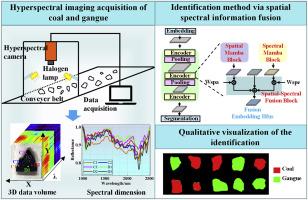基于高光谱图像空间光谱融合的煤、矸石无损快速智能识别
IF 7.5
1区 工程技术
Q1 ENGINEERING, GEOLOGICAL
International Journal of Rock Mechanics and Mining Sciences
Pub Date : 2025-07-01
DOI:10.1016/j.ijrmms.2025.106187
引用次数: 0
摘要
煤矸石鉴定是煤炭工业智能化、绿色化的重要组成部分。传统的煤矸石分选存在效率低、准确性差、适用性有限等问题。本文利用高光谱成像技术无损、快速、信息丰富的特点,提出了一种基于MambaHSI模型的煤矸石识别方法。首先,对煤、脉石高光谱图像进行图像拉伸增强、数据降维、归一化等预处理,提高图像质量和数据处理效率。接下来,为了充分发挥高光谱成像技术“光谱集成”的优势,该模型将整个煤矸石的高光谱图像作为输入。采用端到端训练方法,探索煤和脉石在二维空间的纹理或局部分布差异,以及一维光谱不同波段反射特性的差异。空间特征提取模块(Spatial Feature Extraction Module)致力于在像元水平上识别远距离依赖关系,从而捕获煤的空间分布相干性和相邻像元之间的相互关系。光谱特征提取模块将煤和脉石的光谱向量分割成多个光谱组,并深入研究不同光谱组之间的关系。空间-光谱特征融合模块自适应融合煤和矸石的空间和光谱信息。最后,将该方法应用于三种不同来源的煤和脉石高光谱图像数据集。结果表明:基于MambaHSI模型的分类性能优良,煤、矸石分类的总体准确率可达99.65%;最高平均准确率可达99.62%;Kappa系数可达100%;交叉口与Union的平均比值可达99.56。该方法具有识别精度高、实时性好、鲁棒性强等特点。本研究成果可用于矿区地下煤与矸石的原位、无损、智能识别,促进矸石智能分选的快速发展。本文章由计算机程序翻译,如有差异,请以英文原文为准。

Non-destructive, fast and intelligent identification of coal and gangue via spatial-spectral fusion of hyperspectral images
Coal and gangue identification is a crucial part of the intelligent and green coal industry. Traditional coal and gangue sorting has problems such as low efficiency, poor accuracy, and limited applicability. This article proposes a coal and gangue identification method based on the MambaHSI model, leveraging the non-destructive, fast, and information-abundant attributes of hyperspectral imaging technology. Firstly, the coal and gangue hyperspectral images undergo preprocessing procedures, including image stretching enhancement, data dimensionality reduction, and normalization, with the aim of enhancing image quality and data processing efficiency. Next, in order to fully utilize the advantages of the “spectrum integration” of hyperspectral imaging technology, the model takes the hyperspectral images of the entire coal and gangue as input. Using an end-to-end approach for training, explore the differences in texture or local distribution of coal and gangue in two-dimensional space, as well as the differences in reflection characteristics in different bands of one-dimensional spectra. The Spatial Feature Extraction Module is dedicated to discerning the long-distance dependence relationships at the pixel level, thereby enabling the capture of the spatial distribution coherence of coal and the interrelationships among neighboring pixels. The Spectral Feature Extraction Module segments the spectral vectors of coal and gangue into multiple spectral groups and delves into the relationships between disparate spectral groups. The Spatial-Spectral Feature Fusion Module adaptively integrates the spatial and spectral information of coal and gangue. Finally, the proposed method is applied to hyperspectral image datasets of coal and gangue originating from three distinct sources. The results show that the classification performance based on the MambaHSI model is excellent, and the overall accuracy of coal and gangue classification can reach up to 99.65 %; The highest average accuracy can reach 99.62 %; The Kappa coefficient can reach up to 100 %; The mean Intersection over Union can reach up to 99.56. This method has the characteristics of high identification accuracy, good real-time performance, and strong robustness. The results of this study can be used for in-situ, non-destructive, and intelligent identification of coal and gangue underground in mining areas, promoting the rapid development of intelligent coal gangue separation.
求助全文
通过发布文献求助,成功后即可免费获取论文全文。
去求助
来源期刊
CiteScore
14.00
自引率
5.60%
发文量
196
审稿时长
18 weeks
期刊介绍:
The International Journal of Rock Mechanics and Mining Sciences focuses on original research, new developments, site measurements, and case studies within the fields of rock mechanics and rock engineering. Serving as an international platform, it showcases high-quality papers addressing rock mechanics and the application of its principles and techniques in mining and civil engineering projects situated on or within rock masses. These projects encompass a wide range, including slopes, open-pit mines, quarries, shafts, tunnels, caverns, underground mines, metro systems, dams, hydro-electric stations, geothermal energy, petroleum engineering, and radioactive waste disposal. The journal welcomes submissions on various topics, with particular interest in theoretical advancements, analytical and numerical methods, rock testing, site investigation, and case studies.

 求助内容:
求助内容: 应助结果提醒方式:
应助结果提醒方式:


